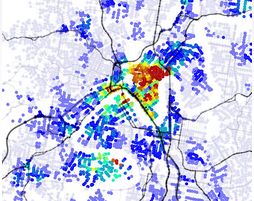The TPACS model simultaneously considers when and whether travel will occur (induced/suppressed demand), destination choice, time of travel, mode choice and route choice. These choices are assessed within the context of a complete multi-modal network, with time-dependent congestion and full timetabled public transport. The route selection allows any combinations of mode, including complexities like: taking bikes onto public transport; chauffeuring; and using CBD public transport loops to travel from car parks to the destination. The model uses a very detailed description of the network and land-use; the network includes all roads, PT services and walk/cycle paths. It does not use traffic zones – all population and activities are located directly onto the transport network. This means that the model does not discriminate against short trips, which might be considered intrazonal trips and often ignored in the traditional four-step model. Details on intrazonal trips modelling can be found in the paper below. The paper, “What goes on inside a zone?”, by Morgan Weston and Peter Davidson highlights the importance of intrazonal trips when considering active and public transport. All these factors make the TPACS model the ideal model for active and public transport.
In addition to this the TPACS model has the flexibility to adjust mode paraments for different market segment. This flexibility allowed us to explore the effect of having no access to a car across Brisbane, Melbourne and Sydney. Additionally walking speeds could be adjusted and government taxi subsidies could be added to the model to see the accessibility of a city for a disabled resident. More information on the outcome of this research can be found in the paper “One City Many Perspectives” by Peter Davidson and Morgan Weston.
Past active and public transport project can be found here
Active Transport in Brisbane
The image below shows active transport mode share in Brisbane’s CBD for journey to work. There is high walking share around centres, particularly the CBD. In the very centre of the CBD, the free bus loop lowers the walking share.

Active Transport in Brisbane
